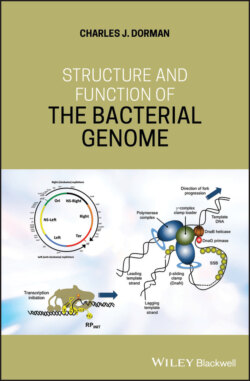Читать книгу Structure and Function of the Bacterial Genome - Charles J. Dorman - Страница 10
Preface
ОглавлениеThe bacterial genome is the software that contains the information for running the cell. The information resides in the genetic material of the bacterium, metaphorically, in both digital (nucleotide sequence) and analogue (DNA topology) forms. From this information emerges the operational hardware, in the form of RNA and proteins, which compose and regulate the pathways for the building of the cell, for the operation of the processes that maintain cell function and which repair and replicate the cell and its contents. Expressing the information that is contained in the cellular software requires sophisticated molecular machines and involves complex processes. Over many decades, molecular microbiology has revealed the details of these machines and processes and has greatly deepened our understanding of the genome itself. By now, the breadth and depth of the information available about these topics can be intimidating, even to experienced investigators. This book will attempt to organize its most important features in ways that allow the reader to grasp the ‘big picture’.
Specialists who focus on ‘the nucleoid’, ‘the cell cycle’, ‘bacterial metabolism’, ‘gene regulation’, ‘transport’, etc. have often studied these bacterial cellular systems and processes in isolation from one another for the very good reason that each is an enormous subject, capable of occupying a whole scientific career. This compartmentalisation of information is valuable because it helps to organize information in discrete packets under clear headings. It is also consistent with the idea of science as an organized body of knowledge. However, even a cursory reading of the literature under the standard headings will reveal that there is tremendous overlap between distinct cellular systems in terms of their components and their governance architecture.
Recently, there has been a great growth in the quantity of data coming from whole‐genome studies of bacterial cells. Experienced investigators may feel that there is just too much information to absorb and the literature is now too vast to read and assimilate. Students entering the field are at an even greater disadvantage and can be forgiven for being discouraged by the mountain of facts. If the discipline of molecular microbiology is to thrive in the future, it is essential that new entrants to the field, and established investigators, have the ability to navigate the sea of information safely. It is the purpose of books like this one to be islands of meaning in this sea of information. This will be done by highlighting the most important components and processes of the bacterial cell, by providing context for cellular operations and by pointing out connections between the different systems and operations. The objective is to provide the reader with a unified picture of the bacterial genome at the structural and functional levels.
Detailed descriptions of the genome's container (the cell envelope) and of the metabolic processes and components that build and maintain it are not within the scope of this book. It will not be possible to provide comprehensive listings of all of the genes and gene products involved in every process that is included because there are just too many, and to attempt this would simply confirm in the reader's mind the impression that this is all just too complicated. Similarly, organism‐to‐organism comparisons will only be made to illustrate important principles; for the most part the narrative will be concerned with the model bacterium Escherichia coli and its close relatives. To attempt wider coverage of the prokaryotic world would simply create an unwieldy book and would defeat its main purposes.
The material in the book is based on the lectures I have delivered to my Junior and Senior Sophister (penultimate and final year) BA students in the Microbiology Moderatorship at Trinity College Dublin over the past 25 years. Although the Microbiology Moderatorship degree at Trinity College is an undergraduate degree, in terms of international comparisons, its advanced content and the demands it places on students are equivalent to taught MSc degrees elsewhere. The lectures seek to introduce the students to the complexities of global gene regulation in model bacteria and how these relate to the structure of the bacterial nucleoid. They are informed by my research in these fields since 1981 and by a close reading of the development of understanding in those fields over the intervening years. This work has been supported by grants from Science Foundation Ireland since 2003. I am grateful to Steve Busby and Jayaraman Gowrishankar for comments on the draft manuscript; the responsibility for any remaining errors of fact or of omission is mine alone.
Dublin 2019
Charles J. Dorman
